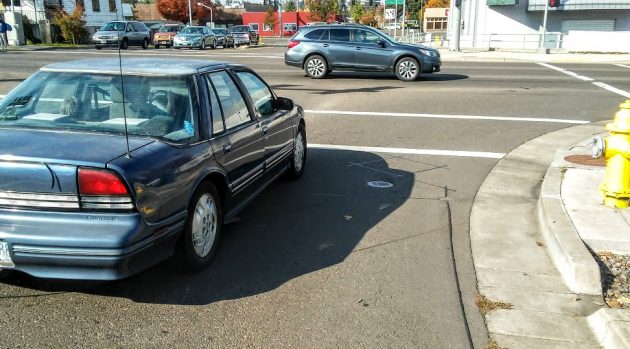
The corner of Oak Street and Ninth Avenue on Oct. 13. Note the faintly visible, diamond-shaped bike detector in the pavement.
It looks harmless enough, but there’s something not quite right with the bike detector installed at the corner of Ninth Avenue when Oak Street was rebuilt a few years ago in front of the Albany Lowe’s.
Actually, two things. One, the detector doesn’t work, in my experience. And two, because it doesn’t work, it’s in the wrong place because when cyclists stand on top of it, waiting, they prevent motorists in the adjacent lane from making a right turn on red when there’s a gap in traffic on Ninth.
You can find out all kinds of stuff online about the technology that makes red signals turn green for motor vehicles, and for bicycles and motorcycles too. Inductive loop detectors work by sending an alternating current through a wire loop in the ground. The current creates a magnetic field. Steel or aluminum bike wheels disturb the magnetic field, and this tells the signal controller that someone is waiting.
Modern detectors shown online (in material from Washington and other states) are circular or square in relation to the bike lane, not the diamond shape visible here. Newer ones also have pavement markings telling a rider exactly where to stop and wait so that the sensor will detect the bike’s wheels.
That section of Oak Street has very little traffic (which makes you wonder why ODOT insisted that it be built, at the cost of millions.) This means that until a car comes along to trigger the light, a bike rider often has to stand there and wait.
The 2015 Oregon law that allows motorcyclists and bike riders to cross on a red signal after waiting “one full cycle” is useless. There are no detectable cycles when the signal just stays red.
If waiting forever at a signal looks to you very much like strictly a First World concern, and a very minor one at that, you are right. But you’d think that when road authorities require that bike detectors be installed — at what cost I do not know — they want to know when one of these gizmos doesn’t work. (hh)


Doesn’t the “Idaho Stop” apply here?
No. It’s a signal, not a stop sign or flashing red light. Anyway, there’s always traffic on 9th, so no time to cross safely against the light.
When did aluminum become ferromagnetic?
It didn’t. But it conducts electricity, and that all it needs to do to actuate an inductive loop detector.
I guess my aluminum rims are different, since they don’t work on any o the sensors.
It may become an issue when a bicyclist is killed trying to cross 9th against the light after waiting – and not getting – a green signal.
Your statement “at the cost of millions”. Are you talking about ODOT requiring the traffic light altogether? I presume not just the inductive loop added for bicycles or motorcycles. Thanks.
ODOT would not allow Lowe’s to be built unless the city improved Oak Street and extended it through the ninth avenue intersection to Pacific. The entire road project cost millions.
Sounds like Bike Glitteratti inside-the-beltway stuff. Take it up with Boshart-Davis. She’s our representative on matters such as this.
I would go up the handicap ramp and push the button before trying to cross THAT intersection.
And have all the whiners complain about riding on the sidewalk?
Rick d has a creative workaround
I notice a round, cast iron cover not far from the sensor. Wonder if that has biased the sensor